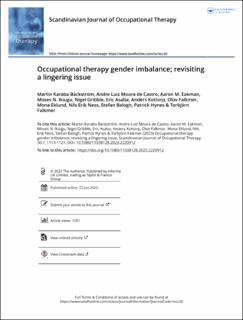| dc.contributor.author | Karaba Bäckström, Martin | |
| dc.contributor.author | Luiz Moura de Castro, Andre | |
| dc.contributor.author | Eakman, Aaron M. | |
| dc.contributor.author | Ikiugu, Moses N. | |
| dc.contributor.author | Gribble, Nigel | |
| dc.contributor.author | Asaba, Eric | |
| dc.contributor.author | Kottorp, Anders | |
| dc.contributor.author | Falkmer, Olov | |
| dc.contributor.author | Eklund, Mona | |
| dc.contributor.author | Ness, Nils Erik | |
| dc.contributor.author | Balogh, Stefan | |
| dc.contributor.author | Hynes, Patrick | |
| dc.contributor.author | Falkmer, Torbjörn | |
| dc.date.accessioned | 2023-12-18T10:25:48Z | |
| dc.date.available | 2023-12-18T10:25:48Z | |
| dc.date.created | 2023-07-07T14:05:15Z | |
| dc.date.issued | 2023 | |
| dc.identifier.issn | 1103-8128 | |
| dc.identifier.uri | https://hdl.handle.net/11250/3107992 | |
| dc.description.abstract | Background
Recently, it has been suggested that gender disparity in Occupational Therapy has to do with segregated gendered job norms that position female dominated professions as a ‘step down’ for many males. Interestingly, this suggestion was not underpinned by experiences of males in the profession.
Aims and Methods
Thirteen male Occupational Therapists with a variety of backgrounds were invited to this Round Table research, focussing on the broader issue of the existing gender imbalance in Occupational Therapy.
Results
Two themes emerged: ‘The core values of the profession’, and ‘Broadening the scope of the profession’; none of them suggesting that male/female imbalance was necessarily the most pressing issue.
Conclusions
A gender-unrelated approach to everyday problem-solving was put forward to achieve increased diversity in Occupational Therapists’ backgrounds, better reflecting the people they serve. By broadening the scope and the way the profession is presented, and encouraging innovative and more entrepreneurially driven approaches, diversity in the workforce could be further facilitated. These findings are discussed within the context of ‘The mutual constitution of cultures and selves’ model.
Significance
Diversity in the Occupational therapy workforce could be further facilitated with a shift in focus away from the male/female perspective to an intersectional approach. | en_US |
| dc.language.iso | eng | en_US |
| dc.publisher | Informa UK Limited | en_US |
| dc.rights | Attribution-NonCommercial-NoDerivatives 4.0 Internasjonal | * |
| dc.rights.uri | http://creativecommons.org/licenses/by-nc-nd/4.0/deed.no | * |
| dc.title | Occupational therapy gender imbalance; revisiting a lingering issue | en_US |
| dc.title.alternative | Occupational therapy gender imbalance; revisiting a lingering issue | en_US |
| dc.type | Peer reviewed | en_US |
| dc.type | Journal article | en_US |
| dc.description.version | publishedVersion | en_US |
| dc.source.volume | 30 | en_US |
| dc.source.journal | Scandinavian Journal of Occupational Therapy | en_US |
| dc.source.issue | 7 | en_US |
| dc.identifier.doi | 10.1080/11038128.2023.2220912 | |
| dc.identifier.cristin | 2161467 | |
| cristin.ispublished | true | |
| cristin.fulltext | original | |
| cristin.qualitycode | 1 | |

